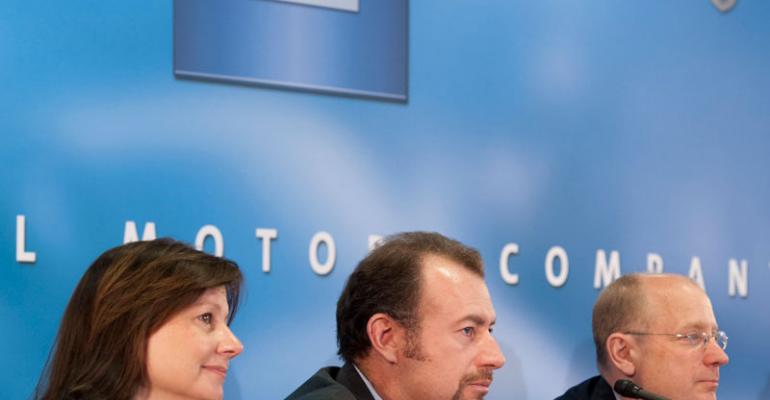General Motors expects to remain a player in the Australian market, but whether that includes functioning as a local producer depends on cost controls and to some extent actions by its competitors, Chief Financial Officer Dan Ammann tells WardsAuto.
“As the world evolves and as the dynamics of how we do business in a particular market change, we adjust course and modify our approach to remain in a viable and profitable position in the market while meeting all the needs of our customer base,” he says, citing in addition to labor costs factors such as trade rules and currency-exchange rates as key decision-driving factors.
“Bottom-line, it is a market that is very important to us. It is a market we will continue to be involved in, one form or another, for the foreseeable future.”
Executives at GM Holden, the Detroit auto maker’s operating group in the country, began negotiations this week with organized labor groups to achieve cost reductions and productivity improvements meant to ensure continued local output in Australia.
GM Holden’s appeal comes on the heels of Ford’s recent announcement it will close its Broadmeadows assembly and Geelong engine plants in 2016, ending 88 years of local production and shifting its business there to an import-only model. The auto maker cited Australian production costs that are four times higher than elsewhere in Asia and twice as high as in Europe, leading to five consecutive years of losses totaling A$600 million ($581.5 million).
GM Holden lost A$152.8 million ($145.1 million) in 2012, as A$226 million ($214.6 million) in restructuring charges swung it into the red. Revenue dropped to A$4.0 billion ($3.8 billion) from A$4.3 billion ($4.1 billion) in 2011 on weaker sales of the Commodore D-car and Cruze C-car, as well as a suspension in sales of the Colorado pickup ahead of a redesigned model coming to market.
GM Holden Chairman and Managing Director Mike Devereux tells Melbourne’s The Age newspaper it costs A$3,750 ($3,548) more to build a GM Holden car in Australia than it does at the company’s other plants worldwide, with A$2,000 ($1,892) due to labor costs alone.
“Our geographic isolation, the cost of sourcing local components and our high labor rates mean we pay a significant premium to manufacture cars here compared to importing,” he is quoted as saying. “'We are more expensive than Germany, the U.K. and Spain – let alone Asia.”
The average pay for production workers at GM Holden is about A$55,000 ($52,047) annually.
To offset the imbalance, GM Holden says it has taken such actions in the past two years as rerating the production line at its Elizabeth assembly plant; investing in locally made vehicles such as the newly redesigned VF Commodore; and pursuing an aggressive pricing and marketing strategy for its cars to compete better against importers such as Mazda and Hyundai, which are benefiting from the high Australian dollar and the country’s internationally low tariff levels.
The auto maker also says it seeks a “clear, consistent and competitive government policy” to support it business there.
GM Holden has received A$1.8 billion ($1.7 billion) in government assistance in the past 12 years and the opposition Liberal-National coalition, heavily favored to win a general election Sept. 14, is promising to cut funding to the auto makers by A$500 million ($473.2 million) if elected.
Ammann reiterates during a discussion Wednesday with WardsAuto GM’s general rule of thumb to build where it sells, which typically insulates the auto maker from wholesale changes in government policy and currency fluctuations.
At the same time, he adds, localized production demands scrutiny whatever the location.
“We have to look at the relative merits of any particular market and what the cost equation is there,” he says. “The Australian market has become increasingly competitive and there are increasing cost challenges. You’ve seen us take some actions to adjust course to some extent, based on what we see, and that will be a dynamic equation as we move forward.”
Ammann says those costs are not restricted to manpower.
“It isn’t any particular element of the cost structure, we have to look at the whole equation: labor, where are our competitors building,” he says. “It’s what our absolute cost position is, but also our cost position relative to our competition.”
Toyota also produces in Australia, although the Japanese auto maker shuttered its Port Melbourne assembly plant in 2006 to consolidate operations in Altona. Mitsubishi closed its manufacturing sites in Australia in 2008.
Earlier this year, GM Holden eliminated 500 jobs, blaming the strong Aussie dollar, and cut production of the Chevrolet Cruze to balance output with demand.
GM Holden operates an assembly plant in Elizabeth in produces global engines in Port Melbourne, dating back to the 1930s. It also serves as one of nine global design hubs for the auto maker, with particular expertise in rear-wheel-drive vehicles, powertrain and alternative fuels.
– with Alan Harman





